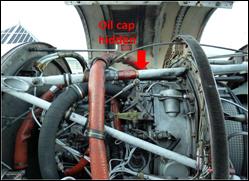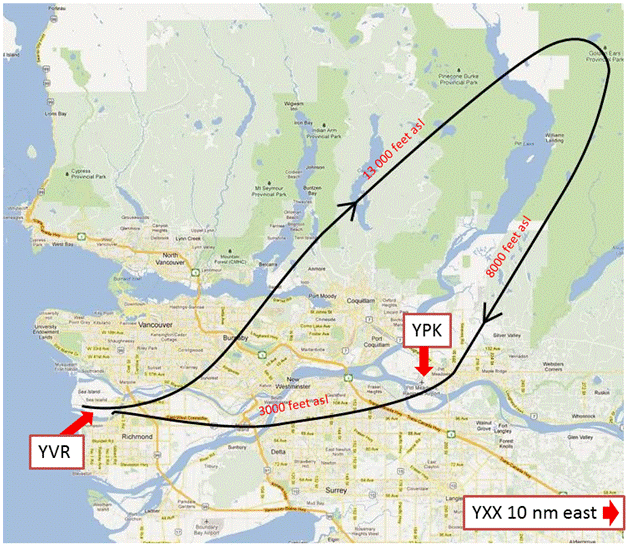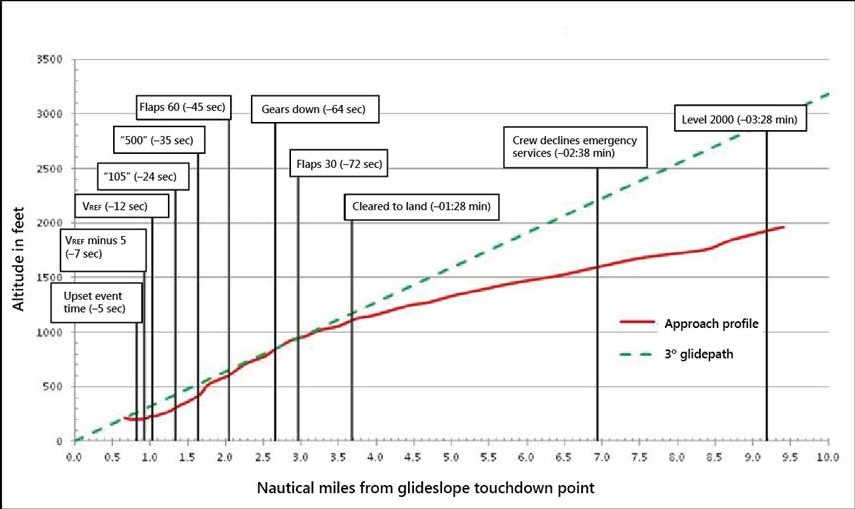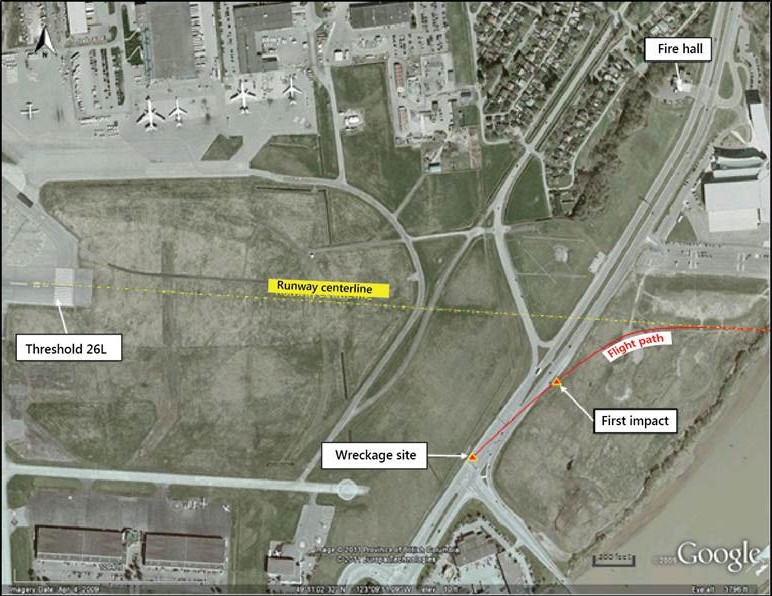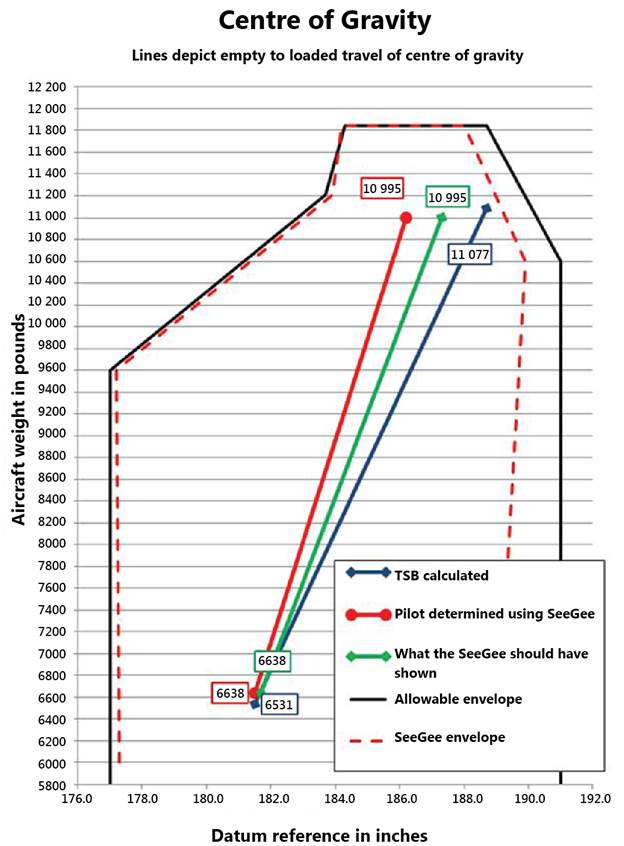Loss of Control and Collision with Ground
Northern Thunderbird Air Inc.
Beechcraft King Air 100, C-GXRX
Vancouver International Airport
Richmond, British Columbia
The Transportation Safety Board of Canada (TSB) investigated this occurrence for the purpose of advancing transportation safety. It is not the function of the Board to assign fault or determine civil or criminal liability. This report is not created for use in the context of legal, disciplinary or other proceedings. See Ownership and use of content. Masculine pronouns and position titles may be used to signify all genders to comply with the Canadian Transportation Accident Investigation and Safety Board Act (S.C. 1989, c. 3).
Summary
The Northern Thunderbird Air Incorporated Beechcraft King Air 100 (serial number B-36, registration C-GXRX) departed Vancouver International Airport for Kelowna, British Columbia, with 7 passengers and 2 pilots on board. About 15 minutes after take-off, the flight diverted back to Vancouver because of an oil leak. No emergency was declared. At 1611 Pacific Daylight Time, when the aircraft was about 300 feet above ground level and about 0.5 statute miles from the runway, it suddenly banked left and pitched nose-down. The aircraft collided with the ground and caught fire before coming to rest on a roadway just outside of the airport fence. Passersby helped to evacuate 6 passengers; fire and rescue personnel rescued the remaining passenger and the pilots. The aircraft was destroyed, and all of the passengers were seriously injured. Both pilots succumbed to their injuries in hospital. The aircraft’s emergency locator transmitter had been removed.
1.0 Factual information
1.1 History of the flight
1.1.1 Sequence of events before the flight
Northern Thunderbird Air Incorporated (NT Air) operated from a fixed-base operator (FBO) at the Vancouver International Airport (CYVR). The aircraft had been in the hangar overnight, where it was inspected by NT Air maintenance personnel. A litre of oil was added to the left engine, and all items of the inspection were signed off as complete.
The captain came into the hangar at about 1420,Footnote 1 spent approximately 2 minutes at the aircraft, then pulled the aircraft out of the hangar, where it was fuelled. The first officer (FO) joined the captain outside of the hangar while the aircraft was being fuelled. A complete pre-flight inspection of the aircraft was not conducted.
The flight was a sub-charter for a different carrier that operated from another FBO at CYVR. The aircraft's engines were started, and the aircraft was taxied to the other FBO to pick up the passengers. During the loading of the passengers, a small puddle of oil under the left engine was pointed out to the pilots. The captain acknowledged the oil, but no further action was taken. The FO carried out the passenger briefing, which included a demonstration of the main-door operation. The aircraft departed the FBO at about 1535.
1.1.2 Accident sequence
The aircraft departed CYVR at 1541, on an instrument flight rules (IFR) flight plan, as Thunderbird Flight 204 (NT204) to Kelowna, British Columbia. The captain was the pilot flying. The flight was uneventful during departure and during its climb to about 16 000 feet above sea level (asl). Approximately 15 minutes into the flight, the crew identified an oil problem. Oil was leaking from the left engine. The FO contacted Air Traffic Control (ATC), and received a clearance to return to CYVR. The captain initiated a turn toward CYVR, and reduced the power for the descent. The passengers were informed that there was an oil leak (photo 1) and that consequently, the flight was going to return to CYVR. About 5 minutes after the turnaround, the “Abnormal” checklist for low oil pressure (figure 1) was consulted.
The pilots decided that the approach would be flown normally, unless the oil pressure dropped below 40 pounds per square inch (psi), at which time they would follow the emergency checklist and single-engine procedures (figure 2). These procedures include a 10-knot addition to the VREF speedFootnote 2 and featheringFootnote 3 the propeller.
The crew received a visual-approach clearance to Runway 26 left (26L) via the interception of the localizer. At about 7 nautical miles (nm) from the runway, at 1500 feet asl, ATC queried the crew concerning the need for deploying emergency equipment. The crew declined the deployment, reporting that everything was good for the moment. At 3.8 nm, with the runway in sight, the crew was cleared to land.
The flight was conducted without incident during the initial approach. Standard calls were made, which included the VREF speed of 99 knots. At 3 nm from the touchdown zone, the flaps were lowered to 30%. That was followed by lowering of the landing gear to the down-and-locked position. From approximately 45 seconds before the upset, the crew's activity increased. The flaps were lowered to 60%. The ground proximity warning system (GPWS) announced the altitude above ground level in feet as “500.” The speed was announced as “105 knots,” then “VREF” (99 knots), and finally “VREF minus 5.” There was a change in the propeller noise and an immediate aircraft upset. The aircraft yawed left, rolled about 80° left, and pitched nose-down about 50°. As the aircraft dove toward the ground, the wings returned to a level attitude and the nose came up, reducing the pitch to 30° nose-down. By that time, the aircraft had collided with the ground. (See Appendix B for the final flight profile and events.)
1.2 Injuries to persons
| Crew | Passengers | Others | Total | |
|---|---|---|---|---|
| Fatal | 2 | − | − | 2 |
| Serious | − | 7 | − | 7 |
| Minor/none | − | − | 3 | 3 |
The aircraft hit the ground on a major arterial road, just outside of the airport perimeter fence. The accident happened at a time when the traffic-light sequence provided a gap in traffic. Several people were stopped at the traffic lights, and helped rescue the passengers. Once the aircraft came to a rest, the passenger seated closest to the main door tried several times to open the door before succeeding. That passenger then helped the next closest passenger out, and persons in the area helped all but 1 passenger out of the burning aircraft. The cockpit was farthest away from the door, and initial rescuers were not aware of the total number of persons on board. By the time 6 of the passengers were out of the aircraft, the fire prevented the initial rescuers from reaching the seventh passenger near the front of the aircraft. Having been informally notified of the accident, Richmond Fire-Rescue personnel arrived about 3 minutes after the crash, from a fire hall about 700 meters from the accident site. They rescued the seventh passenger. The aircraft was across a ditch, just outside of the airport perimeter fence. A Vancouver Airport Authority fire truck arrived about 4 minutes after the crash, having been dispatched by ATC . It was able to spray the wreckage from the airport side of the fence. A second airport fire truck crashed through the gate of the airport perimeter fence to access the accident site. There was some confusion as to the total number of persons on board and how many pilots there were; however, joint fire and rescue personnel extinguished the fire, cut the wreckage, and rescued the pilots.
The aircraft's electrical wiring was arcing, and there was concern for personnel entering the wreckage even after the fire was extinguished.
All of the occupants were transferred to hospital by ambulance services. Two persons from a car that was hit by the aircraft, and a cyclist who was nearly hit, were examined at the site and released.
1.3 Damage to aircraft
The aircraft was destroyed by impact deceleration forces and by fire (see Section 1.12).
1.4 Other damage
The aircraft struck a streetlight pole and a car that was travelling on the road. The road surface was damaged by fuel and oil spills, and by fire. A roadside sign was also damaged by fire.
1.5 Personnel information
Records indicated that the crew members were certified and qualified for the flight in accordance with existing regulations. The captain held a Canadian airline transport pilot licence (ATPL), endorsed with a current group 1 instrument rating and a valid medical certificate. The FO held a Canadian commercial pilot licence (CPL), endorsed with a current group 1 instrument rating and a valid medical certificate.
| Captain | FO | |
|---|---|---|
| Pilot licence | ATPL | CPL |
| Medical expiry date | 01 May 2012 | 01 Feb 2012 |
| Total flying hours | 13 876 | 1316 |
| Hours on type | 978 | 85 |
| Hours, last 90 days | 184 | 192 |
| Hours on type, last 90 days | 46 | 65 |
| Hours on duty before occurrence | 2 | 2 |
| Hours off duty before work period | 38 | 20 |
The captain was experienced in a variety of fixed-wing aircraft operations around the world, including about 7200 hours in twin-engine turboprop aircraftFootnote 4 similar to the accident aircraft.
The FO had started a flying career 4 years previously, and had accumulated about 85 hours on the Beechcraft King Air 100 since joining the company during the previous year.
1.6 Aircraft information
1.6.1 Aircraft
The Beechcraft King Air 100 is a small, pressurized twin-engine turboprop aircraft that is often used in charter and corporate operations.
The aircraft, C-GXRX (photo 2), was configured to operate with 2 crew members and to carry up to 8 passengers, all facing forward. There was no partition between the passengers and the pilots. The Beechcraft King Air 100 is powered by Pratt and Whitney Canada (P&WC) engines.
| Manufacturer | Hawker Beechcraft Inc. |
|---|---|
| Type and model | King Air 100 |
| Year of manufacture | 1970 |
| Serial number | B-36 |
| Certificate of airworthiness issue date | 18 July 2001 |
| Total airframe time | 26 993 hours |
| Engine type (no.) | P&WC PT6A-28 (2) |
| Propeller (no.) | Hartzell HC-B3TN (2) |
| Maximum allowable take-off weight | 11 846 lb |
| Recommended fuel type(s) | Jet A, Jet A-1, Jet B |
| Fuel type used | Jet A |
1.6.2 Airworthiness
Records indicated that the aircraft was certified, equipped, and maintained in accordance with existing regulations and approved procedures. The emergency locator transmitter had been removed for maintenance, and the aircraft was approved to operate without it. No defects were outstanding.
1.6.3 Raisbeck modification
The aircraft had been modified with the installation of a Raisbeck Engineering kit, which included the addition of aerodynamic devices and 4-bladed propellers. These modifications were part of a supplementary type certificate (STC) that was approved by Transport Canada (TC) and the United States Federal Aviation Administration (FAA). The operation of the aircraft was covered by the original Beechcraft Airplane Flight Manual, and the Raisbeck Engineering Airplane Flight Manual Supplement, P/N 91-100/A100.
While the STC improved the aircraft's performance, the minimum speed to maintain control when operating with the critical engineFootnote 5 inoperative (VMC) increased from 81 knots to 85 knots. (See also Section 1.16.5.)
1.6.4 Service bulletins
Service bulletins (SB s) are issued by aircraft, engine, and equipment manufacturers as advisory notices alerting owners and engineers to problems requiring preventive or remedial maintenance, modification, or improvement in product performance. SB s do not have the legal force of airworthiness directives; however, P&WC has compliance guidelines listed by category numbers 1 to 10, with 1 being “before next flight” and 10 being “for information only.”
The engines were subject to a manufacturer's SB , P&WC SB no. 1506R2,Footnote 6 which addresses the issue of leaving the oil reservoir filler cap unsecured. The SB was not adapted as an airworthiness directive by TC or the FAA.
The SB had been initially issued in 1995 as a level 8 bulletin. In 2010, it was re-issued as a level 6 bulletin. The SB stated in part:
C. Reason
To restrict oil loss in the event that the oil-filler-cap is not properly installed in the locked position.
NOTE: Incorporation of this service bulletin does not decrease the requirement to make sure that the oil-filler-cap is properly installed and secured prior to engine installation.
D. Description
The oil-filler-tube is replaced with an oil-filler-tube valve assembly with a ball type check valve. In addition, the oil quantity gage is replaced with a new or modified shortened oil quantity gage.
E. Compliance
CATEGORY 6 − P&WC recommends to do this service bulletin when the subassembly (i.e. module, accessories, components, or build groups) is disassembled and access is available to the necessary part. Do all spare subassemblies.
The accident aircraft was not modified as per the SB , nor was it required to be by regulation.
1.6.5 Transport Canada service difficulty advisory
TC recognized a possible issue with “loose, leaking, or missing oil filler caps” through analysis of the Service Difficulty Reporting System, and as a result, issued a Service Difficulty Advisory in 2006 to owners of affected aircraft. In this advisory,Footnote 7 TC recommended that “all operators, maintainers, overhaul facilities and other interested parties comply with the… P&WC Service Information Letter and Service Bulletins…” and “following engine oil servicing, always double-check to ensure that oil caps are properly fastened.”
1.6.6 Weight and balance
The aircraft was within its operational weight limitations. It was loaded to about 700 pounds below its maximum gross take-off weight. The weight was distributed in a manner that placed the aircraft's centre of gravity close to the aft, but within its forward and aft limits. (See also Section 1.17.2.)
1.7 Meteorological information
The sky conditions were mostly clear, and winds were light and variable. During the aircraft's final approach, the CYVR control tower reported wind from 260º magnetic at 5 knots. The smoke trail from the aircraft blew upwards and toward the west southwest, indicating a light tailwind on the approach to Runway 26L. The temperature was 9ºC. Weather was not considered a contributory factor in this accident.
1.8 Aids to navigation
The diversion back to CYVR was accomplished using ATC radar vectors to intercept the 26L localizer for a visual approach. Aids to navigation were not considered a contributory factor in this accident.
1.9 Communications
The flight was in communication with ATC and NT Air dispatch at all times. The aircraft was equipped with a global positioning system (GPS) tracking system that transmitted the aircraft's position every 6 minutes to the company's operations.
1.10 Aerodrome information
CYVR is located in the suburbs of Vancouver, on an island in the mouth of the Fraser River, at sea level. It is a full-service international airport that supports major airlines. There are 3 runway surfaces, of which 2 are parallel. The approach was accomplished on Runway 26L (Figure 3). Other airports in the vicinity include Pitt Meadows (CYPK) and Abbotsford (CYXX), as indicated in figure 7.
The accident flight was not delayed by ATC at any time after the crew requested clearance to return to CYVR. There was no wake turbulence from aircraft in the vicinity that would have affected the accident flight.
1.11 Flight recorders
The aircraft was equipped with a cockpit voice recorder (CVR), which recorded the complete flight.
There was no flight data recorder, nor was one required by regulation.
1.12 Wreckage and impact
The aircraft initially struck the ground with the nose wheel, which collapsed. Shortly thereafter, both of the propellers and the main landing gears struck the ground simultaneously. The main landing-gear assemblies broke off, and the right-wing outer section broke and overturned from the leading edge to the trailing edge. Fuel lines ruptured, and fuel was spilled onto the roadway, which erupted into fire.
The aircraft skidded on its belly for 558 feet (170 metres) along a heavily travelled arterial roadway consisting of 6 lanes, and clipped a car travelling in the opposite direction. The right side of the nose section of the aircraft struck a streetlight pole that stood on the road's centre median. Subsequently, the nose and tail sections of the aircraft tore from the fuselage, staying attached only by the control cables.
The wreckage left a trail of fire that was consistent with spilled fuel ignited by the landing gear rubbing on asphalt. The right side of the aircraft burned more than the left side (figure 4).
1.13 Medical and pathological information
The investigation determined that there was nothing to indicate that the pilots' performance was degraded by physiological factors.
1.14 Fire
After the aircraft and engines stopped, the fire was concentrated on the right wing and in areas where the aircraft's electrical-system wiring was routed. The wiring converges to the cockpit area and would have been energized by the battery located in the right wing, until it was disconnected by the investigators hours later. The areas of thermal heat and fire damage mostly matched the areas of the aircraft's main electrical wiring (figure 4).
Aircraft certified in Canada are not required to have a safety device that disconnects the battery in the event of an accident. Battery-supplied electrical currents can cause arcing when energized circuits are damaged in accidents.
There was evidence that the emergency oxygen system was compromised during the accident. Leaking oxygen supported an isolated fire in an area above and behind the captain's seat. The oxygen tank is located in the rear of the aircraft, and is plumbed along the inside of the roof to the passenger and pilot locations. The system was found armed. It is normally armed by the crew before take-off, meaning that the oxygen tank valve is in the open position, and the lines are charged with oxygen.
1.15 Survival aspects
The Beechcraft King Air 100 has 1 cabin door, located at the rear of the aircraft on the left side. One emergency exit window is located over the right wing. The cabin was configured with 8 passenger seats, all facing forward in rows, with a centre aisle. Figure 5 shows the cabin configuration and available exits. Fire was visible outside on the right, making the cabin door the only viable exit. The cabin door was opened with difficulty, as the door frame was deformed. All of the passengers and both pilots suffered injuries from the impact, and all but 1 passenger had to be assisted to exit the aircraft. The captain was not wearing a shoulder harness.
All of the persons on board sustained survivable injuries from the impact deceleration forces. The post-impact fire compromised survivability. The pilots suffered severe burns and smoke inhalation. The passenger seated closest to the cockpit suffered burns and the serious effects of smoke inhalation.
1.16 Tests and research
1.16.1 Wreckage examination
Both propeller assemblies were examined in detail, but the only reliable findings were that both propellers had damage consistent with normalFootnote 8 revolutions per minute (rpm) and were not feathered, and that the propeller hubs' internal scars were similar.
Examination of the engines revealed that the left-engine oil-reservoir cap was unlatched (photo 3).Footnote 9
Teardown examination of the right engine showed vertical-impact damage and rotational damage consistent with operation at low power (near idle). Discolouration marks from fire damage indicated that about 7 litres of oil remained in the reservoir after impact.
Teardown examination of the left engine showed similar damage, consistent with operation at low power (near idle). Similar discolouration marks indicated that there was about 0.8 of a litre of oil remaining in the reservoir after impact. This amount, however, was sufficient to cover the oil pump inlet (photo 4), meaning that oil was still being supplied to the engine.
There was no evidence in either engine of pre-impact damage or malfunction that would have limited power.
Both the left and right engines displayed contact signatures to their internal components that were characteristic of the engines producing power in a low power range, possibly at or near flight idle, at the time of impact. The right engine's signatures to the power turbine and power-turbine guide-vane ring were slightly more pronounced than for the left engine, and may suggest that the right engine was at a slightly higher power level.
The control surfaces, linkages, actuators, and cables all appeared to be in serviceable condition before impact.
The CVR, some flight instruments, and all engine instruments were removed and sent to the Transportation Safety Board (TSB) Laboratory for extraction of recorded data. The CVR provided clear acoustic data from the pilots' communications, the engine and propeller, and other system sounds. The instruments did not display any valuable information.
1.16.2 Acoustic examinations
Analysis of the audio recordings from the cockpit revealed acoustic signatures that were consistent with the 4-bladed propellers turning at about 1905 rpm and synchronized until just before the aircraft upset. There was a change in propeller sound; however, both propellers maintained about 1900 rpm. An engine igniterFootnote 10 was on throughout the descent, and continued through to the upset.
1.16.3 Engine oil system (Pratt & Whitney PT6 series)
Each engine has its own oil system that lubricates and cools the engine bearings, heats the fuel, and supplies the propeller governor with oil for its operation. The oil is stored in a reservoir that holds 8.7 litres. Normally, oil venting will be negligible. However, if the oil reservoir is overfilled, oil will leak out of the oil vent when the engine is operating.
The engine oil-pressure pump picks up oil from the reservoir, and as long as the oil supply is not exhausted or interrupted, engine oil pressure will be maintained. Engine-oil temperature may increase as the oil volume decreases, especially if engine loads are high. However, when the oil is depleted, temperature indications are unreliable. When oil leaks from the high-pressure side of the system, there may be a reduction in oil pressure, and the amount of oil leaking may vary with engine power variations (i.e., there is decreased oil loss with decreased power). However, when the leak is from the low-pressure side (return lines and reservoir), engine power variations are unlikely to have any effect on the amount of oil lost. Engine shutdown may limit oil loss in this case.
1.16.4 Propeller control system
Twin-engine aircraft benefit from the use of a feathering propeller-control system. This system allows the pilot to feather the propeller in the event of a loss of power or other engine problems. Feathering the propeller eliminates drag that would be caused by a windmilling, non-feathered propeller. The elimination of drag improves the aircraft's ability to be flown with 1 engine inoperative to the nearest suitable airport.
The engine supplies oil to the propeller governor, which increases the oil pressure in the propeller-control system. The increase in oil pressure offsets a counterweight and spring forces in the propeller hub that feathers the propellers. Valves controlled by the pilot or speed sensors control propeller pitch and rpm. In the event of an engine failure, the oil pressure in the propeller hub takes time to be depleted, so there is a mechanism for pilots to dump that pressure to allow the propeller to feather quickly. Some aircraft are equipped with an auto-feathering system (triggered by low engine-compressor speed or torque). The accident aircraft was not equipped with an auto-feathering system.
1.16.5 Asymmetrical thrust
On twin-engine aircraft where both engines turn clockwise, such as the Beechcraft King Air 100, the left engine is considered critical(Footnote 5). When an engine becomes inoperative, a yaw effect will develop. The yaw effect varies with the lateral distance from the aircraft's centreline to the thrust vector of the operating engine. This effect is amplified by the thrust produced by the operating engine. Due to the P-factor,Footnote 11 the right engine develops its thrust vector further away from the aircraft's centreline than does the left engine. The failure of the left engine will result in a larger yaw effect from the operating right engine (figure 6).
1.16.6 Single-engine control
When thrust from engines off the centreline of an aircraft differs, control of yaw relies primarily on the tail's vertical stabilizer and rudder, and to a lesser extent, the ailerons. The effectiveness of these surfaces increases with speed.
Most multi-engined, fixed-wing aircraft have a minimum control speed (VMC), which is the minimum speed at which the aircraft is directionally controllable with the critical engine inoperative. Below VMC, a pilot may not be able to control the aircraft. VMC for the accident aircraft was 85 knots, based on the inoperative-engine propeller windmilling, a 5° bank toward the operating engine, take-off power on the operating engine, retracted landing gear, flaps in the take-off position, and a most aft centre of gravity.
Information on the minimum speed at which directional control can be maintained with propellers not feathered and at normal rpm is not normally provided to flight crews. However, the propeller manufacturer calculated the drag produced by the aircraft's 4-bladed propeller, turning at about 1900 rpm, to be about 300 pounds.
The application of asymmetrical thrust at low airspeed with both engines operating can result in a loss of directional control.
In August 2012, AvioConsult, an experimental flight-test expert, published a review and recommendations for the improvement of the FAA Airplane Flying Handbook (FAA-H-8083-3A). The review specifically refers to Chapter 12 (Transition to Multiengine Airplanes), and recommends more comprehensive information for pilots to ensure understanding of the aspects of asymmetrical thrust that can lead to a loss of control. Canadian publications are similarly lacking this valuable information.
1.16.7 Aerodynamic stall
An aerodynamic stall occurs when the angle of attack of a wing exceeds the critical angle at which the airflow begins to separate. When a wing stalls, the airflow breaks away from the upper surface, and the amount of lift will be reduced to below that needed to support the weight of the aircraft. While stalls occur at a particular angle of attack, they can happen at a variety of airspeeds. However, those airspeeds can be estimated for given conditions.
Factual information from ATC radar and the CVR indicated that the aircraft was about 20 knots above the stall speed, which was about 72 knots for the load factors present. Also, because the upset came with an apparent power increase, it was determined that a stall was not the initiating event.
1.17 Organizational and management information
1.17.1 Company flight operations
NT Air has been operating in British Columbia and the Yukon since 1971, beginning with off-strip operations in British Columbia's north with float- and ski-equipped aircraft. Since then, it has moved to a fleet of Beechcraft 1900s, King Airs and Cessna Caravans. NT Air covers a large geographical area, providing charter and scheduled services, medical evacuations, corporate travel, and cargo hauls.
1.17.2 Weight and balance
The company was authorized by TC to use a calculator referred to as a “CAVU SEE GEE” (SeeGee) to calculate the aircraft centre of gravity. The SeeGee calculations are quick and easy to prepare, and are fairly accurate compared to the values calculated with weights and moment arms. The SeeGee does not account for fuel values above 800 pounds. The SeeGee manufacturer built in compensation by moving the fore and aft limits of the weight-and-balance (W&B) envelope inward (Appendix D : Weight-and-balance calculations).
The maintenance department did not list the current index value with each change in the empty W&B, so pilots had to calculate the index value based on the latest empty W&B change. The wrong empty W&B was used by the pilots to calculate the index value, and while the W&B was within limits, it was incorrect.
The aircraft's documented operating weight did not include the weight of equipment the aircraft normally carries, which comprised 53 pounds of equipment in the rear baggage area, and 31 pounds of equipment in the cockpit. Refer to Appendix D for the differences in calculations.
1.17.3 Standard operating procedures
1.17.3.1 Pre-flight Inspections
NT Air 's Beechcraft King Air 100 standard operating procedures (SOPs) suggest that the captain delegate the pre-flight inspection of the aircraft. It does not elaborate on this inspection, but the manufacturer's pilot's operating manual (POM), under Normal Procedures – Preflight, includes: “Engine Oil – CHECK QUANTITY, CAP SECURE.”
1.17.3.2 Checklists
The NT Air Quick Reference Handbook does not address engine oil leaks, but it makes reference to low oil pressure in both the abnormal checklist and the emergency checklist (Figure 1 and Figure 2).
While both checklists suggest reducing power, neither cautions the pilot about the effects on the minimum speed to be maintained when engine power is reduced, the propeller is not feathered, and asymmetrical thrust is applied. However, for single-engine operations, the emergency checklist notes that 10 knots is to be added to all VREF speeds.
1.17.3.3 Stabilized Approaches
The SOPs make reference to stabilized approachesFootnote 12 after the final approach fix. The SOPs also specify the criteria of an unstabilized approach, and discuss when a missed approach should be conducted. However, those criteria set limits that would not trigger a missed approach until the aircraft has already exceeded the instrument approach standards set out in the preceding paragraphs of the SOPs. The SOPs lacked clear direction on how the aircraft was to be configured for the last 500 feet, or what to do if an approach is still unstable when 500 feet is reached, specifically in an abnormal situation.
1.17.4 Flight operations training
Turboprop-aircraft flight manuals and training programs do not include cautions regarding single-engine power application with the opposing engine not feathered and minimum control speed for conditions when a propeller is not feathered.
All one-engine−inoperative training scenarios give pilots a clear indication of an engine failure or the requirement to shut down an engine. In every case, it is clear that the pilots have to feather the propeller, with exception of auto-feather−equipped aircraft. All actions and data then assume that the failed engine propeller is feathered.
There were no training scenarios that simulated an aircraft on approach, with low power and low speed and the critical engine (left) not responding to a power demand while the other engine (right) responded. The closest training scenario found was engine failure during a missed-approach procedure. This scenario also gives pilots a clear path of action that includes feathering the failed engine's propeller.
1.17.5 Company maintenance practices
NT Air performs maintenance on its aircraft as an approved aircraft maintenance organization (AMO). As part of the TC-approved maintenance control procedures, the director of maintenance, in coordination with the quality manager, reviews all ADs and SB s for their applicability. Applicable ADs are mandatory; SB s are not.
The overnight maintenance-inspection checklists include “check engine oil level” as one of their tasks. This task implies removing the oil reservoir cap and replacing it; however, there is no check for verifying the security of the cap. The cap is difficult to see when closing the engine cowling (photo 5).
The overnight inspection of the occurrence aircraft was performed by an apprentice aircraft maintenance engineer (AAME). The AAME hired by the company was a graduate of a technical training institute. The apprentice had been working at NT Air for about 6 months, and had carried out several hundred similar overnight inspections before without issue. The AAME was authorized to carry out this inspection without supervision; however, a licenced aircraft maintenance engineer (AME) was required to sign—and did sign—that the inspection was completed.
1.17.6 Safety management system
The company had a safety management system (SMS) in place; however, it was not required and not approved by TC. A fully functioning safety management process would be expected to rigorously challenge and validate any underlying assumptions about safety risks. The company's SMS had not identified company occurrences of oil reservoir caps being left unlatched. The SB had not been assessed by the company's SMS, nor had the company's SMS identified any other mitigation of the risks associated with unlatched oil-reservoir caps.
1.18 Additional information
1.18.1 Previously identified post-crash fire issues
Post-impact fires have been documented as a risk to aviation safety in previous TSB investigations. As well, following TSB Safety Study SII A05-11, completed in 2006, the TSB concluded that requirements to consider and adapt countermeasures in new aeroplane designs may significantly reduce the risk and incidence of post-impact fires in impact-survivable accidents. Therefore, in Recommendation A06-09, issued 29 August 2006, the Board recommended that,
to reduce the number of post-impact fires in impact-survivable accidents involving new production aeroplanes weighing less than 5700 kg, Transport Canada, the Federal Aviation Administration, and other foreign regulators include in new aeroplane type design standards:
- methods to reduce the risk of hot items becoming ignition sources;
- technology designed to inert the battery and electrical systems at impact to eliminate high-temperature electrical arcing as a potential ignition source;
- requirements for protective or sacrificial insulating materials in locations that are vulnerable to friction heating and sparking during accidents to eliminate friction sparking as a potential ignition source;
- requirements for fuel system crashworthiness;
- requirements for fuel tanks to be located as far as possible from the occupied areas of the aircraft and for fuel lines to be routed outside the occupied areas of the aircraft to increase the distance between the occupants and the fuel; and
- improved standards for exits, restraint systems, and seats to enhance survivability and opportunities for occupant escape.
TC responded to this recommendation in November 2006 and January 2007, but because these responses contained no action or proposed action that would reduce or eliminate the risks associated with this deficiency, the overall response to Recommendation A06-09 was assessed as Unsatisfactory.
The Board also found that there are a large number of small aircraft already in service, and the defences against post-impact fires in impact-survivable accidents involving these aircraft are, and will remain, inadequate unless countermeasures are introduced to reduce the risk. The most effective ways to prevent post-impact fires in accidents involving existing small aircraft are to eliminate potential ignition sources, such as hot items, high-temperature electrical arcing and friction sparking, and to prevent fuel spillage by preserving fuel-system integrity in survivable crash conditions. Technology that is known to reduce the incidence of post-impact fires by preventing ignition and containing fuel in crash conditions may be selectively retrofitted to existing small aircraft, including helicopters certified before 1994. Therefore, in Recommendation A06-10, issued 29 August 2006, the Board recommended that,
to reduce the number of post-impact fires in impact-survivable accidents involving existing production aircraft weighing less than 5700 kg, Transport Canada, the Federal Aviation Administration, and other foreign regulators conduct risk assessments to determine the feasibility of retrofitting aircraft with the following:
- selected technology to eliminate hot items as a potential ignition source;
- technology designed to inert the battery and electrical systems at impact to eliminate high-temperature electrical arcing as a potential ignition source;
- protective or sacrificial insulating materials in locations that are vulnerable to friction heating and sparking during accidents to eliminate friction sparking as a potential ignition source; and
- selected fuel system crashworthiness components that retain fuel.
TC responded to these recommendations in November 2006 and January 2007, but because these responses contained no action or proposed action that would reduce or eliminate the risks associated with this deficiency, TC's overall response to Recommendation A06-10 was assessed as Unsatisfactory.
A similar study was also conducted in the United States by the National Transportation Safety Board (NTSB)Footnote 13 in 1980, which led to Recommendations A-80-90 to A-80-95. The status of 4 out of these 5 recommendations is now listed as “Closed − Unacceptable Action.” The only recommendation listed as “Closed − Acceptable Action” is A-80-094, which states:
The NTSB recommends that the Federal Aviation Administration: Assess the feasibility of requiring the installation of selected crash resistant fuel system components, made available in kit form from manufacturers, in existing general aviation aircraft on a retrofit basis and promulgate appropriate regulations.
The FAA started the rule-making process to introduce standards for fuel fittings; however, the process was stopped based on the results of the cost-benefit analysis.
While fuel sources for fire are difficult to contain, some ignition sources may be more practical to isolate. There are several potential ignition sources in crash conditions, like friction and component heat, sparks from metal contact, and electrical arcing. The source of electrical arcing can be overcome, and the automotive industry worldwide has done this by installing small, simple, and inexpensive g-switches at battery connectors. These devices function by having switches with predetermined g-load activation that disconnect the current from the battery, thereby de-energizing the electrical system. Informal discussion with a major aviation battery manufacturer suggests that designing a disconnect switch for the battery is possible, and would make aircraft retrofit simple (i.e., involving replacement of the battery with a new type). It is important to note that de-energizing the battery also de-energizes electrical fuel-boost pumps that may be on. The combination of pressurized fuel flow and continuous ignition can create a fire that is difficult to extinguish.
1.19 Useful or effective investigation techniques
Information gathered from security cameras provided information on the preparation of the aircraft before the flight.
2.0 Analysis
2.1 General
Except for the unlocked left-engine oil filler cap, examination of the wreckage revealed no pre-existing mechanical conditions that would have contributed to the accident. The following analysis focuses on human factors, the operation of the aircraft, aerodynamic characteristics of the aircraft, and crash survivability.
2.2 Engine oil leak
Latching the oil reservoir cap after checking and adding oil is not specifically described in the Northern Thunderbird Air (NT Air) B-100 overnight-inspection check sheet, but it is a requirement. It is likely that the oil cap was not secured or verified during completion of the overnight inspection.
Before the flight, an oil puddle was discovered under the left engine after the aircraft was taxied to pick up the passengers at a different fixed-base operator (FBO). The crew was aware of this oil, but no further action was taken to determine the source. Overfilling the oil reservoir will cause oil to vent, but it could not be determined whether the captain thought that this was the cause.
The investigation determined that, while a significant amount of oil had leaked from the left engine through the unsecured oil filler cap, enough remained to allow the engine and propeller to operate normally.
2.3 Service bulletin
The non-mandatory modification cited in Pratt and Whitney Canada (P&WC) Service Bulletin (SB) no. 1506R2 could have limited the oil loss from the left engine during the flight. The SB was not implemented, and no alternative actions were taken to mitigate the risk identified in the SB . While the engine manufacturer had identified enough occurrences of unsecured oil-reservoir caps to issue a SB , NT Air had not identified any issues within its operations, and did not implement the modification or otherwise address the issue through its safety management system (SMS).
2.4 Northern thunderbird air Beechcraft King Air 100 standard operating procedures
The company standard operating procedures (SOPs) call for the captain to delegate the daily or pre-flight inspection of the aircraft. However, it was the practice that the captain usually completed the pre-flight inspection. In this case, the captain did not perform a complete pre-flight inspection, which should have identified the unsecured oil cap.
The crew reviewed the Low Oil Pressure checklist, but did not brief themselves on or fly the aircraft as per the “one-engine approach checklist,” which included a 10-knot addition to the calculated landing reference (VREF) speed.
The SOPs did not give effective directions for stabilizing the aircraft before 500 feet above the touchdown zone, specifically in an abnormal situation. The VREF speed was based on full flaps, and the flaps were still in transition when the upset occurred. The final approach was not stabilized for the last 500 feet.
2.5 Diversion choice
Because the oil leak was from the engine's oil reservoir, oil pressure would not be lost immediately. If there were an indication of declining oil pressure, it would go from normal pressure to no pressure quite quickly. This situation would allow the affected engine to operate normally until several litres of oil were lost. The captain's decision to return to Vancouver International Airport (CYVR) was reasonable, given the aircraft's location (Figure 7). An emergency descent was not in order, given the problem. Using a normal descent profile from 16 000 feet, the aircraft would have had to be flown away from the closer (in horizontal distance) aerodrome, Pitt Meadows (CYPK), or in circles to get down to it. Other aerodromes were no closer in flight time, and CYVR was also the best choice considering operational needs (home base).
2.6 Emergency/non-emergency
The crew of NT204 had no indication of a problem identified as an emergency situation, and it was not normal to declare an emergency for an oil leak. The pilots would have known that the oil leak might eventually become a problem, and it is reasonable to conclude that they would have declared an emergency if the oil pressure had dropped below 40 pounds per square inch (psi).
It was fortuitous that Richmond Fire-Rescue personnel were informed of the aircraft crash by a passerby who witnessed it, and the firefighters self-dispatched, arriving at the scene about 3 minutes after the crash. The CYVR fire and rescue personnel responded when air traffic control (ATC) sounded the alarm after impact, and arrived at the scene 4 minutes after the crash.
2.7 Aircraft configuration and control speeds
There was no published minimum control airspeed for the aircraft as it was configured; all available information suggests that airspeed would have been more than 85 knots. The captain allowed the aircraft to slow below the VREF speed of 99 knots. It is possible that the captain was trying to reach the runway without adding power, and was trading airspeed for altitude.
The aircraft had slowed below the VREF speed and below the minimum speed to maintain directional control for its configuration during the final stages of the approach to land. The captain took action to regain VREF speed by adding power; when power was added, it was likely added only to the right engine. Having the left engine at idle and the propeller not feathered caused the aircraft to yaw left due to asymmetrical thrust/drag. The asymmetrical thrust was compounded by the P-factor, as the angle of attack increased when the aircraft slowed. Because the airspeed was low, the rudder was not effective enough to arrest the yaw.
These combined effects caused the aircraft to yaw left and roll, and to pitch down.
The captain likely initiated a recovery by reducing the right engine's power. However, there was insufficient altitude to recover before colliding with the ground.
Multi-engine−aircraft flight manuals and training programs do not include cautions and minimum control speeds for use of asymmetrical thrust in situations when an engine is at low power or the propeller is not feathered. There is a risk that pilots will not anticipate aircraft behaviour when using asymmetrical thrust near or below these unpublished critical speeds, and will lose control of the aircraft.
2.8 Passenger safety
The first officer's pre-flight passenger briefing instructions helped a passenger open the door, which proved to be the only viable exit. The door was stuck closed, but eventually was opened from the inside. The emergency exit window was over the wing, and there was fire outside of that exit, making it unusable.
2.9 Post-impact fire
Impact damage broke fuel lines and spilled fuel that ignited, causing significant fire and smoke. Some of the fire-damaged areas match the main electrical-wiring areas of the aircraft, possibly because damaged wiring powered by the battery supported fire in those areas. This hypothesis is supported by evidence that electrical arcing occurred until the battery was disconnected by investigators.
While fuel sources for fire are difficult to contain, ignition sources are more practical to isolate. There are several sources of ignition, such as friction and component heat, sparks from metal contact, and electrical arcing. As previously identified in Transportation Safety Board (TSB) Safety Study SII A05-11, without improvements in aircraft design, there is a high risk of post-impact fires ignited by electrical arcing after damage to aircraft.
The source of electrical arcing can be mitigated by devices that function by having switches with predetermined gravitational acceleration (g-load) activation that disconnect the current from the battery, thereby de-energizing the aircraft's wiring.
Very few aircraft are designed with mechanisms to disconnect battery power when high deceleration forces are experienced. Without impact-related battery-disconnect systems, there is a risk of ongoing personal injury from post-impact fire.
2.10 Weight-and-balance calculations
While the aircraft departed with a weight and balance (W&B) that was within the allowable envelope, the data used by the crew were erroneous. Errors in W&B calculations can cause aircraft to depart while outside of the allowable W&B envelope.
3.0 Findings
3.1 Findings as to causes and contributing factors
- During routine aircraft maintenance, it is likely that the left-engine oil-reservoir cap was left unsecured.
- There was no complete pre-flight inspection of the aircraft, resulting in the unsecured engine oil-reservoir cap not being detected, and the left engine venting significant oil during operation.
- A non-mandatory modification, designed to limit oil loss when the engine oil cap is left unsecure, had not been made to the engines.
- Oil that leaked from the left engine while the aircraft was repositioned was pointed out to the crew, who did not determine its source before the flight departure.
- On final approach, the aircraft slowed to below VREF speed. When power was applied, likely only to the right engine, the aircraft speed was below that required to maintain directional control, and it yawed and rolled left, and pitched down.
- A partially effective recovery was likely initiated by reducing the right engine’s power; however, there was insufficient altitude to complete the recovery, and the aircraft collided with the ground.
- Impact damage compromised the fuel system. Ignition sources resulting from metal friction, and possibly from the aircraft’s electrical system, started fires.
- The damaged electrical system remained powered by the battery, resulting in arcing that may have ignited fires, including in the cockpit area.
- Impact-related injuries sustained by the pilots and most of the passengers limited their ability to extricate themselves from the aircraft.
3.2 Findings as to risk
- Multi-engine−aircraft flight manuals and training programs do not include cautions and minimum control speeds for use of asymmetrical thrust in situations when an engine is at low power or the propeller is not feathered. There is a risk that pilots will not anticipate aircraft behaviour when using asymmetrical thrust near or below unpublished critical speeds, and will lose control of the aircraft.
- The company’s standard operating procedures lacked clear directions for how the aircraft was to be configured for the last 500 feet, or what to do if an approach is still unstable when 500 feet is reached, specifically in an abnormal situation. There is a demonstrated risk of accidents occurring as a result of unstabilized approaches below 500 feet above ground level.
- Without isolation of the aircraft batteries following aircraft damage, there is a risk that an energized battery may ignite fires by electrical arcing.
- Erroneous data used for weight-and-balance calculations can cause crews to inadvertently fly aircraft outside of the allowable centre-of-gravity envelope.
4.0 Safety action
4.1 Safety action taken
4.1.1 Northern Thunderbird Air Inc.
On 27 December, 2011, Northern Thunderbird Air Incorporated issued an “Online Training Centre” communication to all employees regarding pilots electing to operate turbine engines on reduced (single-engine) power. The communication stated in part:
Be warned that power settings below 500ft/lbs torque in the Beech 1900s and 100s and below 10% torque in the Beech 350 may produce undesirable or uncontrollable yaw as airspeed decreases.
Also on 27 December, 2011, the company issued a Beechcraft King Air 100 standard operating procedures bulletin that stated in part:
…130KTS shall be maintained until the aircraft is:
- In final landing configuration;
- Is on final approach slope to the runway;
- The airport visual reference is obtained; and
- The PF verbalizes “target VREF”.
4.1.2 Transport Canada
Transport Canada is working with the engine manufacturer to improve implementation of Pratt and Whitney Canada Service Bulletin (P&WC SB) no. 1506R2 to mitigate the consequences of an unsecured oil filler cap. The implementation may include mandating the subject design change for this and other engines.
4.2 Safety concern
4.2.1 Post-crash−fire risk reduction
This accident highlights issues for which the Board has previously made recommendations addressed at reducing the risk of post-crash fires. A 2006 Transportation Safety Board (TSB) safety study of post-impact fires (SII A05-01) identified that in 128 of 521 occurrences, fire or smoke inhalation contributed to the cause of death or serious injuries. Most of the accidents were otherwise survivable.
Hot engine exhaust ducts, engine exhaust gases and flames, and hot engine parts were common “hot item” sources of ignition. There were 91 fire-related fatalities in accidents where a hot exhaust duct was the probable source of ignition, 32 fatalities associated with hot exhaust gases and flames, and 9 fatalities associated with hot engine parts. The primary defences against hot items becoming sources of ignition in crash conditions are to shield hot engine parts from flammable liquids and prevent fuel spillage onto engines. At present, there are no design requirements that reduce the risk of or defend against hot items becoming an ignition source for post-impact fire in small-aircraft accidents.
Electrical arcing, wires, and batteries were also common electrical sources of ignition. In accidents where electrical arcing was a probable source of ignition, there were 104 fire-related fatalities. Electrical arcing has been identified as a common post-impact−fire ignition source in other aviation reports and papers as well, including the NTSB report General Aviation Accidents: Postcrash Fires and How to Prevent or Control Them (NTSB -AAS-80-2). There are no regulatory requirements that specifically address the proximity of potential electrical-ignition sources to combustible material, or the control or suppression of impact-related electrical-ignition sources in small-aircraft accidents.
Friction sparking occurs when ferrous metals, such as those used in landing-gear components, exhaust pipes or ducts, and engine mounts, come into contact with hard surfaces, such as rocks, concrete, or asphalt. In accidents where friction was a probable source of ignition, there were a total of 58 fire-related fatalities. The primary defence against friction heating and sparking is to insulate spark-producing ferrous metals with non-ferrous materials, or otherwise protect the components so as to prevent direct contact with hard surfaces during accidents. There are no design requirements that reduce the risk of or defend against friction becoming an ignition source for post-impact fire in small aircraft.
Therefore, in Recommendations A06-09 and A06-10, issued 29 August 2006, the Board recommended that,
to reduce the number of post-impact fires in impact-survivable accidents involving new production aeroplanes weighing less than 5700 kg, Transport Canada, the Federal Aviation Administration, and other foreign regulators include in new aeroplane type design standards:
- methods to reduce the risk of hot items becoming ignition sources;
- technology designed to inert the battery and electrical systems at impact to eliminate high-temperature electrical arcing as a potential ignition source;
- requirements for protective or sacrificial insulating materials in locations that are vulnerable to friction heating and sparking during accidents to eliminate friction sparking as a potential ignition source;
- requirements for fuel system crashworthiness;
- requirements for fuel tanks to be located as far as possible from the occupied areas of the aircraft and for fuel lines to be routed outside the occupied areas of the aircraft to increase the distance between the occupants and the fuel; and
- improved standards for exits, restraint systems, and seats to enhance survivability and opportunities for occupant escape.
and,
to reduce the number of post-impact fires in impact-survivable accidents involving existing production aircraft weighing less than 5700 kg, Transport Canada, the Federal Aviation Administration, and other foreign regulators conduct risk assessments to determine the feasibility of retrofitting aircraft with the following:
- selected technology to eliminate hot items as a potential ignition source;
- technology designed to inert the battery and electrical systems at impact to eliminate high-temperature electrical arcing as a potential ignition source;
- protective or sacrificial insulating materials in locations that are vulnerable to friction heating and sparking during accidents to eliminate friction sparking as a potential ignition source; and
- selected fuel system crashworthiness components that retain fuel.
This accident investigation revealed evidence of live battery-powered circuits after the aircraft came to a stop, and fire in areas like the cockpit, where electrical wiring is concentrated. Both pilots died from burn-related injuries. More needs to be done to reduce the risks associated with post-crash fires.
The Board is concerned that if no action is taken by Transport Canada to address the recommendations made in the 2006 TSB Safety Study, SII A05-1, ignition sources will remain and the risk of post-crash fire will persist.
This report concludes the Transportation Safety Board's investigation into this occurrence. Consequently, the Board authorized the release of this report on . It was officially released on .
Appendices
Appendix A – List of Transportation Safety Board Laboratory Reports
The following Transportation Safety Board (TSB) Laboratory report was completed:
- LP 166/2011 – Instrument Examination
This report is available from the Transportation Safety Board of Canada upon request.
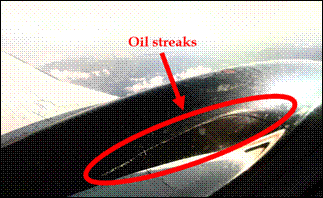
![Image of Abnormal checklist for low oil pressure (Source: Northern Thunderbird [NT] Air Quick Reference Handbook](/sites/default/files/eng/rapports-reports/aviation/2011/a11p0149/images/a11p0149-figure-1.png)

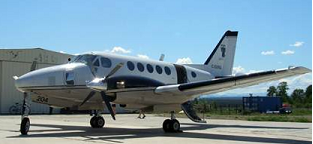
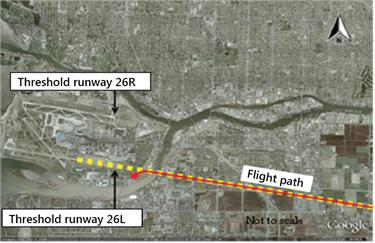
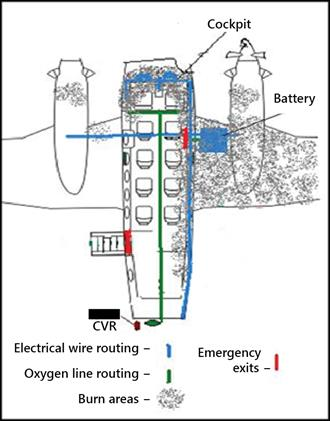
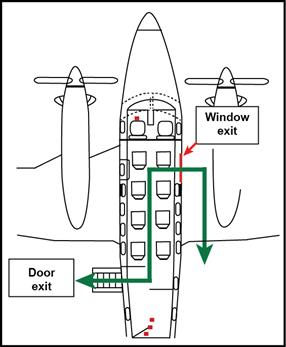
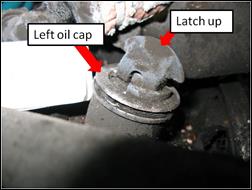
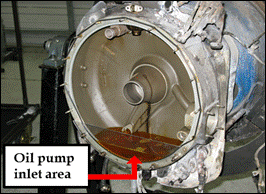
![Figure 6. – Airplane Flying Handbook, FAA-H-8083-3A [US Government Printing Office, Washington DC: 2004], page 12−28. Modifications by TSB.)](/sites/default/files/eng/rapports-reports/aviation/2011/a11p0149/images/a11p0149-figure-6.png)
